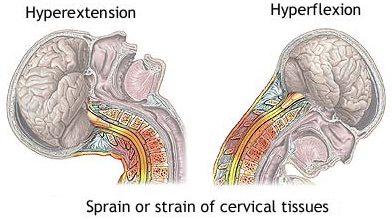|
10/10/2016 0 Comments Whiplash and Chiropractic Care Each year more than 3 million Americans are treated for whiplash injuries and many more suffer from symptoms that go untreated because they are mistaken for general neck pain. Due to weaker neck muscles, and possibly an increased willingness to report, women are more likely to suffer from whiplash than men are. Moreover, anyone currently experiencing degenerative disc disease symptoms or neck pain, in general, is more likely to be affected by whiplash during their lifetime. Whiplash is an umbrella term for any damage done to the ligaments, muscles, discs, nerves, or vertebrae as a result of a sudden forceful movement of the neck; first the neck moves slightly backwards at impact before jolting forward and quickly slamming backwards. This forceful movement can cause a cervical injury, or mild to severe trauma to the vertebrae and surrounding matter. Whiplash is most often associated with car accidents but can also be found in contact sports, amusement parks, and even when someone slips and falls. Following a sports injury, or especially a car accident, one should consider being evaluated for whiplash given the risk factor and the long term consequences of going untreated. Symptoms vary depending upon the severity of the trauma but most commonly felt symptoms include a stiff or painful neck, pain in arms and hands, muscle spasms, headaches, dizziness, vertigo, fatigue, ringing ears, disturbed sleep, a numbness or tingling in the arms and hands, and even low back pain. If left untreated whiplash can lead to chronic neck pain, a decrease in mobility, permanent damage to the vertebrae and nervous system, as well as accelerated degeneration of the cervical spine. It is imperative that you seek treatment for any sort of neck and head trauma as they can lead to a spinal cord injury and subsequently damage to the nervous system. Furthermore, it is recommended that a chiropractor be involved in your rehabilitation process as they can assess the neck and spinal column to ensure that they remain properly aligned and at the peak of performance. Neck stiffness and pain alone are enough without the unnecessary addition of dizziness, ringing ears, and numbness of an entire limb. Your chiropractor can help you create a multi-faceted treatment plan that suits your needs. Treatment plans often include, but are not limited to, ultrasound therapy, electrical stimulation, spinal manipulation, soft tissue therapy, massage, trigger point therapy, and stretching/resistance exercises. The combination of treatments will help treat the various aspects that contribute to whiplash pain by reducing inflammation, improving blood flow, stimulating muscles, alleviating muscle tension and spasm, and restoring motion. In conclusion, whiplash, although a mundane injury and often described as if it were harmless, should be evaluated and treated as soon as possible as it can be excruciatingly painful for many weeks and has the potential to become a chronic cause of pain later in life. Sources http://www.spineuniverse.com/conditions/whiplash/chiropractic-care-whiplash http://www.spine-health.com/treatment/chiropractic/chiropractic-treatments-whiplash http://www.satterwhitechiropractic.com/data/uploads/Stats%20and%20Risk%20Factors.pdf (image) http://www.elitesportandspinewi.com/auto-accident-injuries/ Katie LaBarge St. Lawrence University '16 Chiropractic Assistant
0 Comments
Leave a Reply. |
AuthorMalorie Gardner, D.C. Archives
October 2016
Categories |
Website by North Shore Solutions
 RSS Feed
RSS Feed